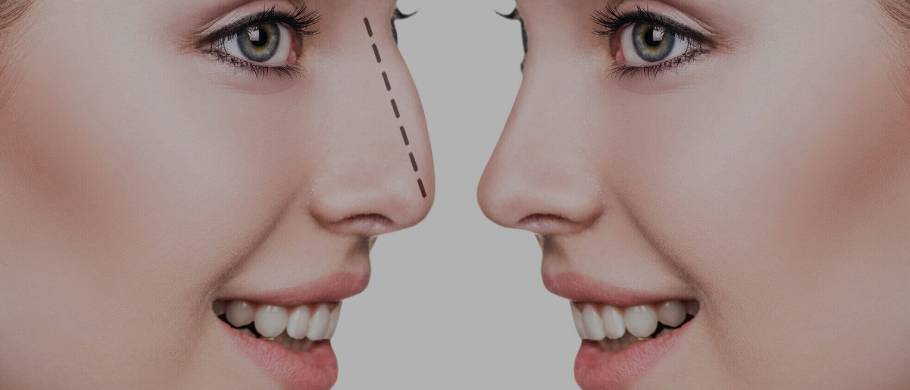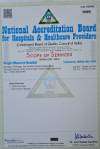Rhinoplasty (RIE-no-plas-tee) is a surgery that changes the shape of the nose. The motivation for rhinoplasty may be to change the appearance of the nose, improve breathing, or both.
The upper portion of the structure of the nose is bone, and the lower portion is cartilage. Rhinoplasty can change bone, cartilage, skin or all three. Talk with your surgeon about whether rhinoplasty is appropriate for you and what it can achieve.
When planning rhinoplasty, your surgeon will consider your other facial features, the skin on your nose, and what you would like to change. If you’re a candidate for surgery, your surgeon will develop a customized plan for you.
Why it's done?
Rhinoplasty can change the size, shape or proportions of your nose. It may be done to repair deformities from an injury, correct a birth defect or improve some breathing difficulties.

Risks:
As with any major surgery, rhinoplasty carries risks such as:
- Bleeding
- Infection
- An adverse reaction to the anesthesia
Other possible risks specific to rhinoplasty include but are not limited to:
- Difficulty breathing through your nose
- Permanent numbness in and around your nose
- The possibility of an uneven-looking nose
- Pain, discoloration or swelling that may persist
- Scarring
- A hole in the septum (septal perforation)
- A need for additional surgery
- Talk to your doctor about how these risks apply to you.
How you prepare:
Before scheduling rhinoplasty, you must meet with your surgeon to discuss important factors that determine whether the surgery is likely to work well for you. This meeting generally includes:
- Your medical history: The most important question your doctor will ask you is about your motivation for surgery and your goals. Your doctor will also ask questions about your
- medical history: including a history of nasal obstruction, surgeries and any medications you take. If you have a bleeding disorder, such as hemophilia, you may not be a candidate for rhinoplasty.
- A physical exam: Your doctor will conduct a complete physical examination, including any laboratory tests, such as blood tests. He or she also will examine your facial features and the inside and outside of your nose.
- The physical exam helps your doctor determine what changes need to be made and how your physical features, such as the thickness of your skin or the strength of the cartilage at the end of your nose, may affect your results. The physical exam is also critical for determining the impact of rhinoplasty on your breathing.
- Photographs: Someone from your doctor’s office will take photographs of your nose from different angles. Your surgeon may use computer software to manipulate the photos to show you what kinds of results are possible. Your doctor will use these photos for before-and-after assessments, reference during surgery and long-term reviews. Most importantly, the photos permit a specific discussion about the goals of surgery.
- A discussion of your expectations: You and your doctor should talk about your motivations and expectations. He or she will explain what rhinoplasty can and can’t do for you and what your results might be. It’s normal to feel a little self-conscious discussing your appearance, but it’s very important that you’re open with your surgeon about your desires and goals for surgery.
- If you have a small chin, your surgeon may speak with you about performing a surgery to augment your chin. This is because a small chin will create the illusion of a larger nose. It’s not required to have chin surgery in those circumstances, but it may better balance the facial profile.
- Once the surgery is scheduled, you’ll need to arrange for someone to drive you home if you’re having outpatient surgery.
What you can expect?
Rhinoplasty does not have an ordered series of steps. Each surgery is unique and customized for the specific anatomy and goals of the person having the surgery.
During the surgery
Rhinoplasty requires local anesthesia with sedation or general anesthesia, depending on how complex your surgery is and what your surgeon prefers. Discuss with your doctor before surgery which type of anesthesia is most appropriate for you.
- Local anesthesia with sedation: This type of anesthesia is usually used in an outpatient setting. It’s limited to a specific area of your body. Your doctor injects a pain-numbing medication into your nasal tissues and sedates you with medication injected through an intravenous (IV) line. This makes you groggy but not fully asleep.
- General anesthesia: You receive the drug (anesthetic) by inhaling it or through a small tube (IV line) placed in a vein in your hand, neck or chest. General anesthesia affects your entire body and causes you to be unconscious during surgery. General anesthesia requires a breathing tube.
Rhinoplasty may be done inside your nose or through a small external cut (incision) at the base of your nose, between your nostrils. Your surgeon will likely readjust the bone and cartilage underneath your skin.
Your surgeon can change the shape of your nasal bones or cartilage in several ways, depending on how much needs to be removed or added, your nose’s structure, and available materials. For small changes, the surgeon may use cartilage taken from deeper inside your nose or from your ear. For larger changes, the surgeon can use cartilage from your rib, implants or bone from other parts of your body. After these changes are made, the surgeon places the nose’s skin and tissue back and stitches the incisions in your nose.
If the wall between the two sides of the nose (septum) is bent or crooked (deviated), the surgeon can also correct it to improve breathing.
After the surgery, you’ll be in a recovery room, where the staff monitors your return to wakefulness. You might leave later that day or, if you have other health issues, you might stay overnight.
After the surgery
After the surgery you need to rest in bed with your head raised higher than your chest, to reduce bleeding and swelling. Your nose may be congested because of swelling or from the splints placed inside your nose during surgery.
In most cases, the internal dressings remain in place for one to seven days after surgery. Your doctor also tapes a splint to your nose for protection and support. It’s usually in place for about one week.
Slight bleeding and drainage of mucus and old blood are common for a few days after the surgery or after removing the dressing. Your doctor may place a “drip pad” — a small piece of gauze held in place with tape — under your nose to absorb drainage. Change the gauze as directed by your doctor. Don’t place the drip pad tight against your nose.
To further lower the chances of bleeding and swelling, your doctor may ask that you follow precautions for several weeks after surgery. Your doctor may ask you to:
- Avoid strenuous activities such as aerobics and jogging.
- Take baths instead of showers while you have bandages on your nose.
- Not blow your nose.
- Eat high-fiber foods, such as fruits and vegetables, to avoid constipation. Constipation can cause you to strain, putting pressure on the surgery site.
- Avoid extreme facial expressions, such as smiling or laughing.
- Brush your teeth gently to limit the movement of your upper lip.
- Wear clothes that fasten in the front. Don’t pull clothing, such as shirts or sweaters, over your head.
In addition, don’t rest eyeglasses or sunglasses on your nose for at least four weeks after the surgery, to prevent pressure on your nose. You can use cheek rests, or tape the glasses to your forehead until your nose has healed.
How To Reach Us?
Dr. Suraj Giri is a trusted ENT Specialist in PCMC, Pune. He has made many happy patients in his 12 years of journey as a ENT Specialist. At Devgiri Memorial Hospital you will get all the necessary medical treatment. Our advanced approach for our patient treatments make us unique.
The appointment process at Devgiri Memorial Hospital PCMC Pune is very simple. You can directly call on 09657002695. Also with the help of the “Book an Appointment” Form you can book your appointment by just filling in the basic information. We will contact you via email or phone call to confirm your appointment.



